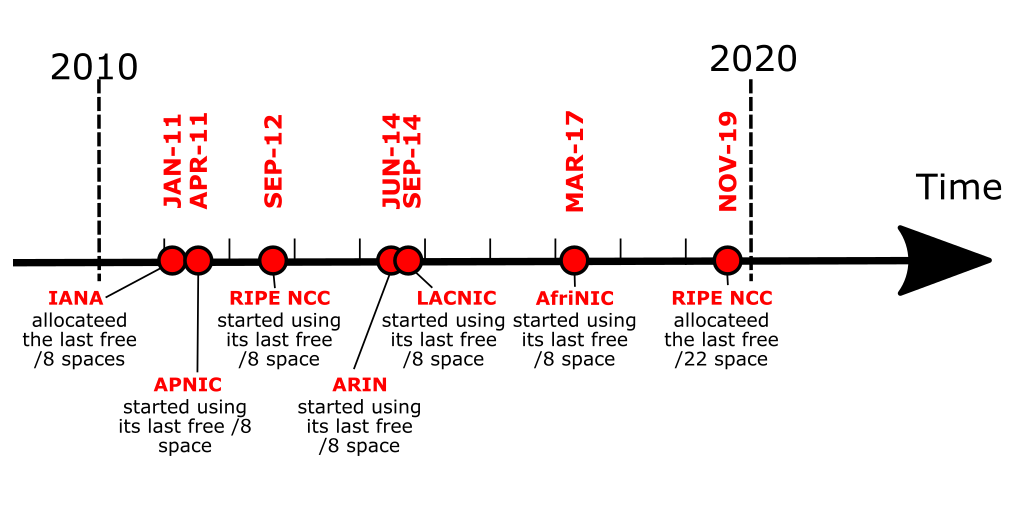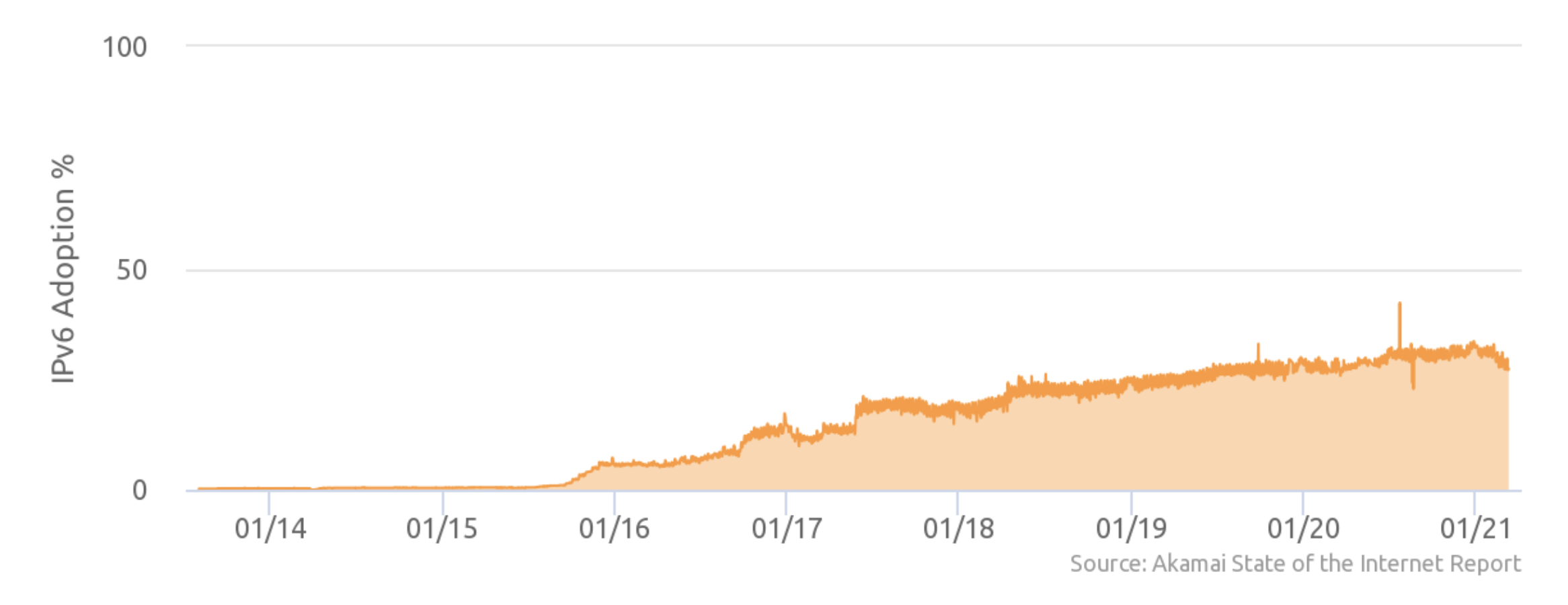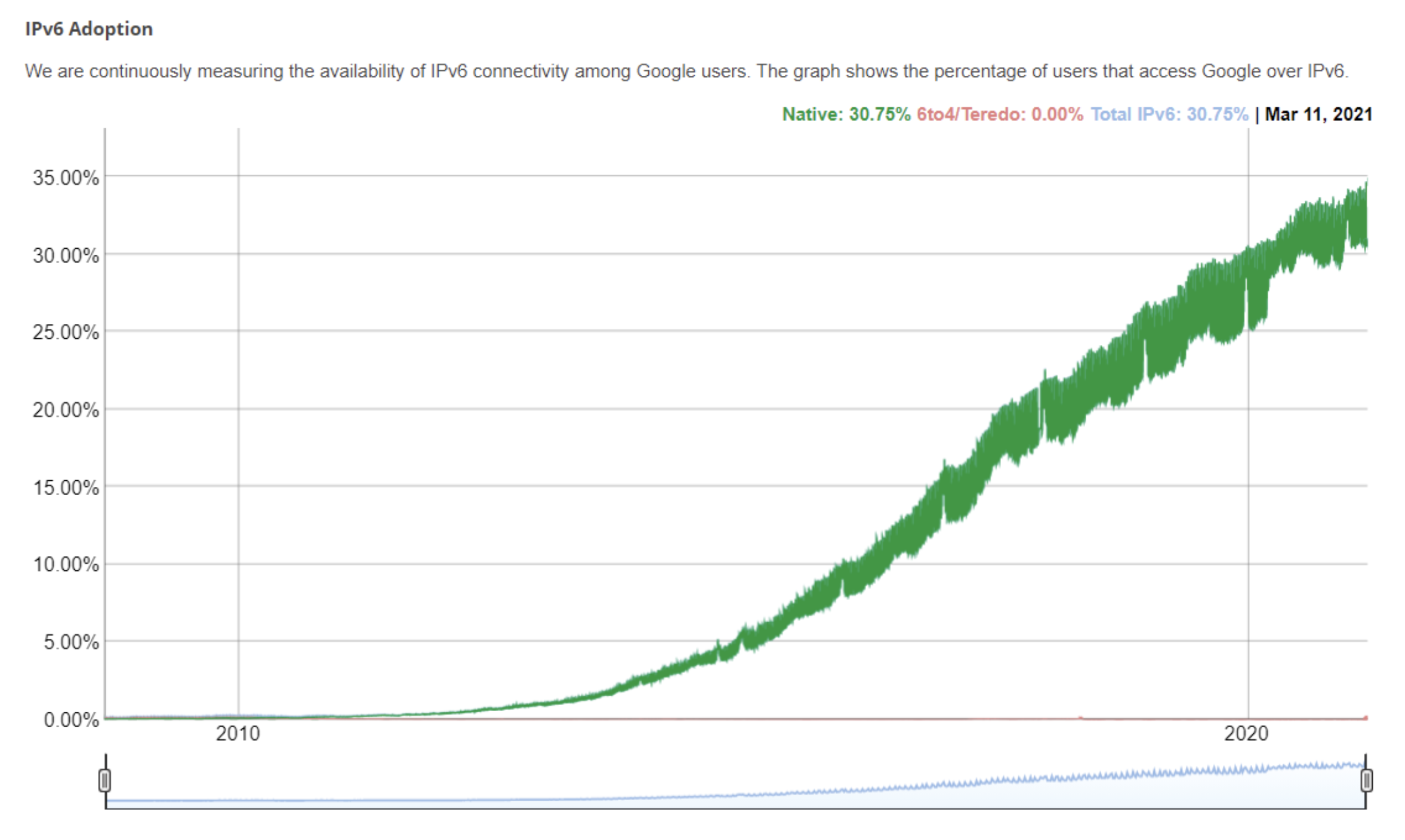An Internet Protocol (IP) is the communications protocol system used to identify and locate computers or devices on networks, and thereby route traffic across the internet. When the global internet was first designed in 1973, IPv4 (Internet Protocol version 4) became the underlying protocol. However, the internet’s founders did not anticipate the explosion of users and devices connected to the world wide web. The address space allocation of IPv4 — similar to telephone numbers — is sufficient for only 4.3 billion termination points on the internet. Its store of 32-bit addresses was never intended to facilitate the formation of the global commercial internet as it exists today.
As a result of the expansion of the global internet, and the increase in connected computers and devices, the IPv4 address pool was essentially depleted by November 2019, with only Africa’s Regional Internet Registry (RIR) having a few /22 address spaces left. This has resulted in an IPv4 address transfer market, where organizations with an excess of IPv4 resources can either return them to the RIR or sell them to another organization that qualifies for resources under an RIR policy. When ISPs run out of viable IPv4 addresses, an ISP may not be able to give individual subscribers their own IPv4 address. Instead, to conserve resources, they may opt to put customers behind Carrier Grade Network Address Translation (CGN, NAT).
Engineers began to recognize that IPv4 depletion would become a problem in the early 1990s, and developed the next generation protocol, IPv6, which supports 340,000,000,000,000,000,000,000,000,000,000,000,000 or 340 trillion trillion trillion addresses. IPv6 was formally adopted by the Internet Engineering Task Force in 1998. This new protocol is comprised of unique, 128-bit addresses (as opposed to IPv4’s 32-bit addresses), and can therefore accommodate an exponential growth of connected computers.
Figure 25. IPv4 Exhaustion in IANA and the RIRs. Source:Michel Bakni - IANA, APNIC, RIPE-1 RIPE-2 LACNIC, ARIN and AfriNIC., CC BY-SA 4.0170.
While IPv6 has existed as a protocol for more than 20 years, uptake has been slow. Because the majority of the internet continues to be accessible via IPv4 only, IPv6 must coexist side-by-side with the fully functional IPv4 public internet. This “dual stack” architecture will continue to be necessary into the foreseeable future, until such a time that IPv6 becomes the default standard.
“Tunneling” is one method that allows IPv4 and IPv6 to coexist. When two systems on the edge of a network support IPv6, but the routers on the public internet between them do not, IPv6 packets can be put inside IPv4 packets, and “tunneled.” Additionally, IPv6 packets can be translated into IPv4 packets utilizing NAT64 — a Network Address Translation technique.
Without the expansion of IPv6, and eventual replacement of IPv4, the evolution of the internet — including the expansion of the Internet of Things (IoT), the “industrial internet” and sensor networks — will be limited by the resource and network management constraints of IPv4. The sheer quantity of devices projected to come online cannot be supported by IPv4. The future of internet connected devices and sensor networks relies on the transition to IPv6.
Google collects and publishes statistics on IPv6 adoption rates based on the percentage of users accessing Google with an IPv6 connection. According to its statistics, Canada has adopted IPv6 at a rate of 30.13%, whereas the United States has adopted IPv6 at a rate of 44.87%171.
Figure 26. IPv6 adoption in Canada and the US based on accessing Google via an IPv6 connection, as of March 13, 2021172.
Akamai shows Canada at 27.3%, but also shows significant growth in the country since 2015. It ranks Canada as 25th in the world in terms of IPv6 adoption.
Figure 27. IPv6 adoption in Canada based on Akamai (a content delivery network and edge server provider), as of March 13, 2021173.
The incredible proliferation of mobile IP devices, including IoT devices, has likely forced ISPs into IPv6. An example of the movement to IPv6 when working with massive IoT type devices took place in British Columbia in 2014. B.C. Hydro implemented a network with nearly 2 million gas meters. Using an IPv6 based network seriously reduced the complexity in rolling out that solution174.
Figure 28. Global IPv6 adoption over time based on accessing Google via an IPv6 connection, as of March 11, 2021175.
The Internet Society measures and reports elements of global IPv6 deployment via the World IPv6 Launch website. Of the 255 networks monitored, Rogers Communications is ranked 19th overall in IPv6 traffic, with over 75% IPv6 deployment on its network. TELUS is close behind at 22nd overall and over 59% deployment on its network. Bell, the operator of SuperNet, is well behind at 65th overall and a mere 9.73% IPv6 deployment on its network176.
As stated earlier, the implementation of NAT significantly decreased the pressure to move to IPv6. As such, there has been a gradual but steady increase in IPv6 implementation in Alberta and across Canada. Of note, the Government of Alberta did require Bell to enable IPv6 on SuperNet so that public sector organizations can make the move when they are ready.
References
170Wikimedia. IPv4 IANA and RIR exhaustion time line - Wikimedia Commons. Accessed 13 March 2021.
171Google. IPv6 Statistics, North America. Accessed 13 March 2021.
172Google. IPv6 Adoption Statistics. Accessed 13 July 2016.
173Akamai. State of the Internet IPv6 Adoption Visualization | Akamai. Accessed 13 March 2021.
174Cisco. BC Hydro, Cisco and Itron - a Powerhouse in Canada - Cisco Blogs. 24 June 2014.
175Google. IPv6 Adoption Statistics. Accessed 13 March 2021.
176Internet Society. World IPv6 Launch Measurements. Accessed 13 March 2021.



